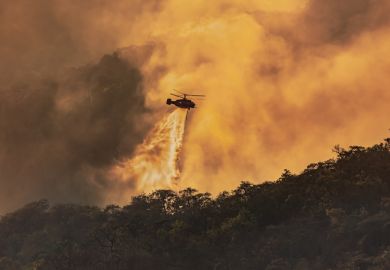"Landscape" first entered the English language from the Netherlands in the 16th century, at the time when the Dutch were actively manipulating and redesigning their lands with new engineering methods for drainage. Landschap , like the German Landschaft , meant both a place where people lived and a pleasing object. Landscapes have inspired painters and poets in all cultures, and their designs have made many a view famous, even iconic. Often artistic representations themselves have gained worldwide recognition, entering cultures and becoming as important as the real landscape.
It is all too easy, though, to forget that landscapes are also partly social constructions, with many different meanings bound up in them.
A grassy hillock catches the eye, and sets off distant woods. To another viewer, though, the hill is a burial mound with ancient significance, or, worse, hides the bodies of a recent war crime.
The modern agricultural revolution of the second half of the 20th century transformed landscapes and brought unprecedented levels of food production.
World food production grew by 145 per cent in the 40 years to 2000, and by 25 per cent per head, despite the great population growth. But this extraordinary "success" still masks the persistent hunger of 800 million people.
Landscapes hide many ills, acts of unkindness and savagery by people on other people, and further acts of outright destruction of nature. Yet we look upon many old landscapes with pleasure, as they often embody something deeply important to a whole culture - the dark, mysterious forests of central Europe, or the wide prairies and steppes of North America or central Asia, or the spectacular rice terraces of Asian hillsides.
In Remaking the Landscape , Jennifer Jenkins has brought together a dozen contributors in a single volume to reflect and speculate on the nature of the British landscape. Throughout these essays, the notion of the land is seen as something to do with both nature and people. Landscapes are part of our heritage, both the good and thebad. They are also shaped by our desires, actions and policies.
Important questions and contradictions are posed. Would we like more woodlands, or large fields with distant hedgerows? Would we like more houses facing grand views? Yes, if we live in them; no, if we want to walk nearby. Should there be more roads to ease our transport worries? How do we look after our communities on the margins of the economy? Above all, what are our collective attitudes to the land? Do we care enough, or are we content to see important environmental and cultural resources slip away through gradual degradation and damage?
The British landscape is strongly shaped by the business of food production, yet it is of deeper cultural significance to many. It is painted, fashioned into poetry and song, and widely celebrated in formal and informal ceremonies. All too rarely these perspectives are brought to bear on the dry policy debates about the future of the land and its communities.
James Hunter reflects on the regeneration needs for the Highlands and Islands, the only part of Britain with fewer people than 5,000 years ago.
He tells stories of the sorrow in the land, the deep significance of the crofting way of life, and the timeless connections between Gaelic literature and language, and the lands they describe. He also points to an important problem that has pervaded thinking about wildernesses since the world's first national park was established at Yellowstone in 1872. Few wildernesses are really wild - most have been shaped by the actions of local people, who are later removed by the more powerful when they wish to control and protect the land. Hunter writes: "An unpeopled Highland glen may look like wilderness or wild land (but) these landscapes are stereotypically devoid of humanity because human communities associated with them for five millennia or more were removed from them - often in circumstances of great brutality - just two to three lifetimes ago."
Richard Keen's essay on heritage landscapes in Wales picks up many other stories - the fragility of rural communities, the lack of jobs, the seasonal movement of livestock that shaped the land and its communities, the rise and fall of the coal and steel industries. The mining and ironworks around Blaenafon are now designated a World Heritage site, yet only a century ago, some 250,000 people were employed there in grey-black valleys now restored to grasslands but stripped bare of their rich political life.
Bryn Green writes on the farmed landscape and reminds us that Britain is still extraordinarily rich in wildlife and scenic beauty. "It is possible, in a morning, to walk from mudflats and salt marshes through sand dunes, pine forests, oak woods, meadows, pasture and arable land, and out onto heaths and downs. In some parts of Europe, one might have to drive for hours to see such variety; in the US, for days." He reminds us that the landscapes we value are created by us: "Where were the meadows of butterflies and daisies, the fields of poppies, the skylarks and lapwings before the forests were cleared?"
What we decide to do with our farming, whether to go larger and more global, or smaller and more local, will affect our landscapes. As consumers, we daily have the opportunity to affect the land through the choices about the food we eat. We can select food from known systems of production that benefit the environment, or employ more people; or we can be indifferent and consume anonymous foods.
Other essays show the inherent dynamic nature of the land. We tend to believe there is something permanent about what we see. Yet this is not the truth. Philip Lowe's gloomy reflections on the effects of the foot-and-mouth crisis, and Ian Hodges' and Uwe Latacz-Lohmann's suggestions on how the lowland landscapes can go beyond a paradigm that seems to maximise production at all costs, show how rapidly things can change.
Simon Jenkins' and Marion Shoard's concerns are with the urban landscapes and edgelands. Nature does not have to be grand for us to enjoy it. Indeed, with more and more people living in urban settings, it is nearby nature that is most accessible - the city park, community garden or allotments, urban heathland and patch of woodland all provide great value for local people. But how do we protect these? And what will we do about the sprawl of "commercial blocks of extraordinary ugliness" that surround many of our oldest towns, as Jenkins puts it?
Other essays provide useful perspectives on history (David Cannadine), on the probable effects of climate change (Crispin Tickell), on population pressures and changing household compositions (John Clarke), on the value of ancient woodlands (Oliver Rackham), and on the effects of sustainable development on our planning systems (David Bannister).
Despite the broad scope of the book, important questions remain. How will the population decline affect landscapes half a century from now? How will our choices about food, and our knowledge of where it comes from, affect our health? The emerging obesity epidemic is partly related to the way we view food systems - can changes in these systems affect our food behaviour and positively benefit public health? What about the role of large corporations in food and farming systems: can the pursuit of more for shareholders ever lead to more sustainable outcomes in rural communities? Finally, what are the connections between the British landscape and that of poorer countries? We are able to maintain ours partly because of high levels of subsidies, yet farmers in poor countries have to survive without such support, and are denied access to our markets, so they remain poor.
As the book's editor puts it: "The one thing that is certain about British landscapes is that they will change, and change dramatically." The key issue is whether we can, collectively, create lands we can all enjoy without compromising their ability to produce the foods we want. As Peter Senge has said: "Nothing will change in the future without fundamentally new ways of thinking. To think that the world can ever change without changes in our mental models is folly." This book should certainly help provoke some of these changes.
Jules Pretty is professor of environment and society, University of Essex.
Remaking the Landscape: The Changing Face of Britain
Editor - Jennifer Jenkins
ISBN - 1 86197 375 6
Publisher - Profile Books
Price - £20.00
Pages - 298
Register to continue
Why register?
- Registration is free and only takes a moment
- Once registered, you can read 3 articles a month
- Sign up for our newsletter
Subscribe
Or subscribe for unlimited access to:
- Unlimited access to news, views, insights & reviews
- Digital editions
- Digital access to THE’s university and college rankings analysis
Already registered or a current subscriber? Login



